文章內容
Generations of Mobile Phones
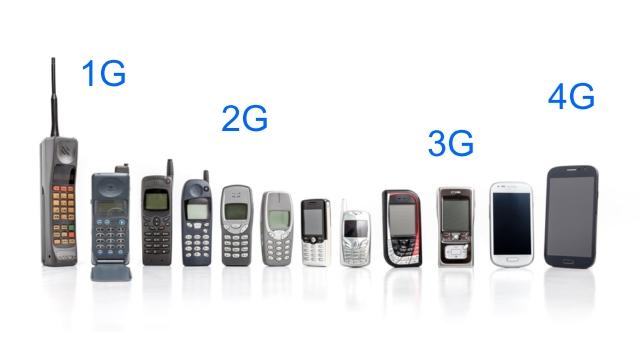
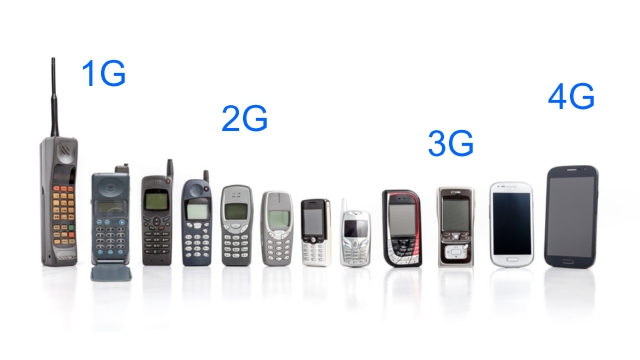
❒ Generation and Development of Mobile phones
Mobile phones have different generations according to different development periods and technologies, including first generation (1G), second generation (2G), third generation (3G) mobile phones, until the most popular fourth generation (4G) and the fifth generation (5G) under development. The titles and development for each generation of mobile phones are shown in Fig. 1.
➤ 1G mobile phone: Using analog signal modulation technologies, such as AM, FM, PM, and belonging to analog mobile phone, which can only transmit voice signal, like the DynaTAC by Motorola in 1983.
➤ 2G mobile phone: Using digital signal modulation technologies, such as ASK, FSK, PSK, and belonging to digital mobile phone, which can only transmit voice signal. The first cell phone owned by most people should be a 2G mobile phone.
➤ 3G mobile phone: Using digital signal modulation technologies, such as PSK, QAM, and Code Division Multiple Access (CDMA) technology to discriminate data for different users with different codes (orthogonal spread spectrum codes)
➤ 4G mobile phone: Using digital signal modulation technologies, such as PSK, QAM, and Orthogonal Frequency Division Multiplexing (OFDM) to transmit signals with sub-carriers of different orthogonal frequencies, which can transmit both voice signals and data packets.
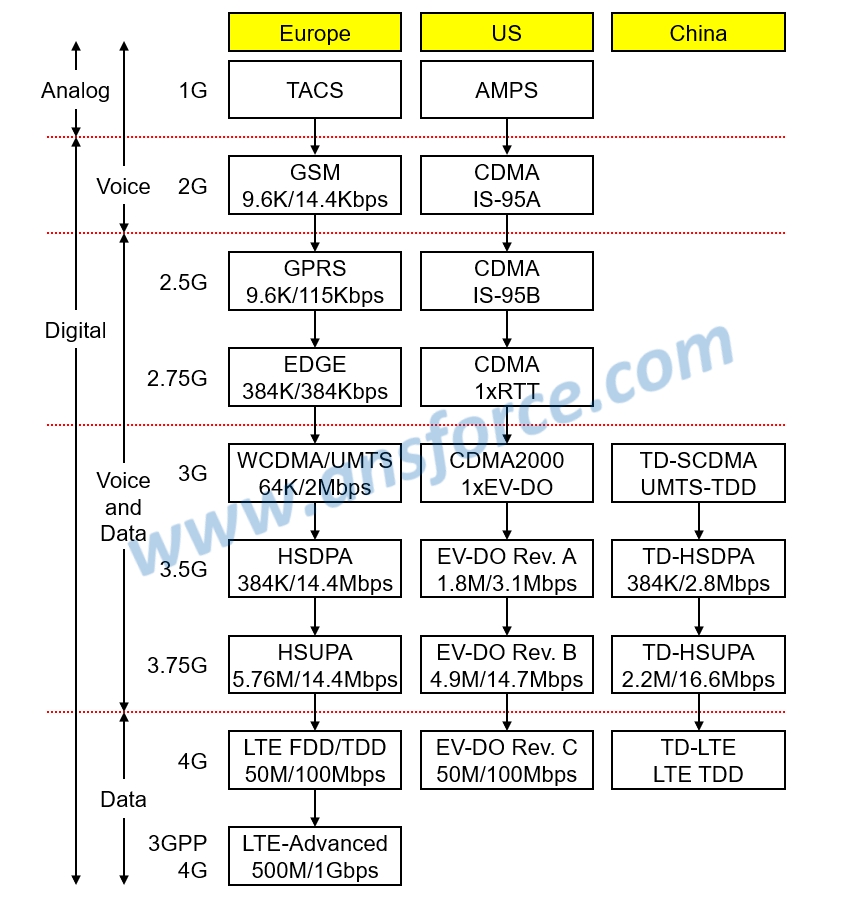
Figure 1: Generations of Mobile phones.
❒ 1G mobile phone
1G mobile phone utilized analog signal modulation technologies, such as AM, FM, PM, to transmit analog signals, and belonged to analog mobile phone. 1G mobile phone systems used in different countries are shown in Table 1.
➤ Advanced Mobile Phone System (AMPS): Developed and applied by USA manufacturers.
➤ Total Access Communication System (TACS): Developed and applied by European manufacturers.
➤ Nippon Telegraph and Telephone (NTT): Developed and applied by Japanese manufacturers.
For example, DynaTAC by Motorola in 1983 was a very large black phone using American AMPS system.
Table 1 Comparison of 1G mobile phones.
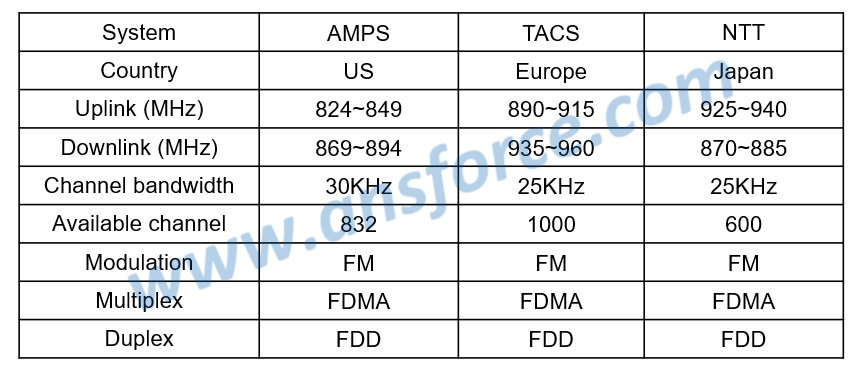
❒ 2G mobile phone
2G mobile phone utilized digital signal modulation technologies, such as ASK, FSK, PSK, to transmit digital signals, and belonged to digital mobile phone. 2G mobile phone systems used in different countries are shown in Table 2.
➤ Digital Advanced Mobile Phone System (DAMPS): Developed by digitizing the first generation AMPS system with the formal standard number IS-54 and IS-136.
➤ Global System for Mobile (GSM): Developed and applied by European manufacturers, including GSM900/1800, wherein GSM1800 is also called DCS1800(Digital Cellular Standard)
➤ Japanese Digital Cellular (JDC): Developed and applied by European manufacturers.
➤ Code Division Multiplex Access (CDMA): Developed and applied by USA manufacturers with the formal standard number IS-95, and the first system using Code Division Multiple Access (CDMA) technology.
Table 2 Comparison of 2G mobile phones.
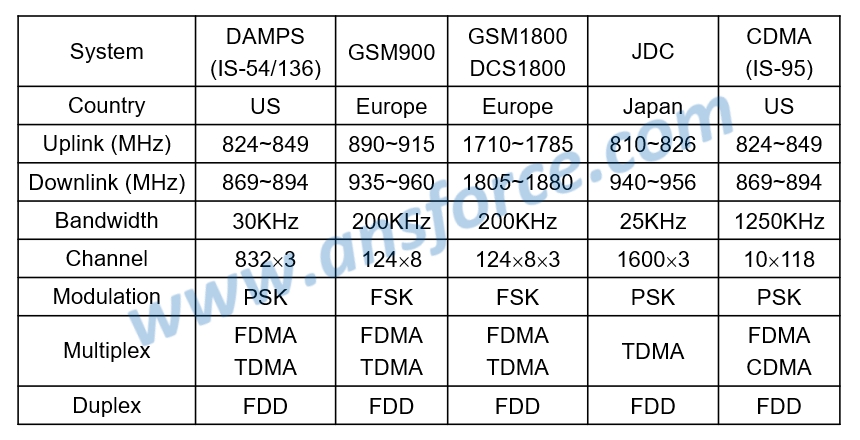
❒ Features of 2G mobile phone
➤GSM900/1800 system: GSM900/1800 has been applied in over 50% of regions worldwide, including a part of Europe and America (GSM1900) and most of Asia countries. As shown in Table 2, GSM900 has an upload frequency of 890~915MHz (bandwidth 25MHz), a download frequency of 935~960MHz (bandwidth 25MHz), and belongs to Frequency Division Duplexing (FDD). GSM900 employs both Frequency Division Multiple Access (FDMA) and Time Division Multiple Access (TDMA) to provide 124x8=992 voice channels, wherein each voice channel is of 200KHz. The communication quality is the same as a conventional radio, which is not so good but acceptable. Because GSM900 system were widely accepted by the market and 992 voice channels were obviously not enough, GSM1800 system was developed thereafter, and has an upload frequency of 1710~1785MHz (bandwidth 75MHz), a download frequency of 1805~1880MHz (bandwidth 75MHz), and provides 124x8x3=2,976 voice channels that is three times of GSM900 system. Because the spectrums of 890~960MHz and 1710~1880MHz have been occupied in USA, 1850~1990MHz is used as the communication frequency for GSM system, so-called GSM1900.
➤CDMA system: CDMA system has been applied in over 20% of regions worldwide, including USA, Korea, Hong Kong, and a part of China. CDMA is the Code Division Multiple Access technology and is related to code computation technology of digital signal. In the early stage, CDMA was used by USA military, and was opened to been applied in commercial applications thereafter. As shown in Table 2, CDMA system has an upload frequency of 824~849MHz (bandwidth 25MHz), a download frequency of 869~894MHz (bandwidth 25MHz), and belongs to FDD. CDMA employs both FDMA and CDMA to provide 10x118=1,180 voice channels.
Because the technologies for 3G mobile phone are very difficult and were developed very slow, GSM system in Europe first announced simpler 2.5G GPRS system and 2.75G EDGE system, and CDMA system of USA (IS-95A) also announced 2.5G CDMA(IS-95B) system and 2.75G CDMA (1xRTT) system in response, as shown in Fig. 1.
❒ 3G mobile phone
3G mobile phones utilize digital signal modulation technologies, such as PSK, QAM, to transmit digital signal, and Code Division Multiple Access (CDMA) technology to discriminate data for different users with different codes (orthogonal spread spectrum codes) and belongs digital mobile phone. 3G mobile phone systems used in different countries are shown in Table 3. 3G mobile communication standard IMT-200 authorized by International Telecommunication Union (ITU) includes:
➤ Wideband CDMA (WCDMA): Co-developed and applied by European and Japanese manufacturers.
➤ CDMA2000: Co-developed and applied by USA and Korean manufacturers.
➤ Time Division Synchronous CDMA (TD-SCDMA): Developed by China.
Table 3: Comparison of 3G mobile phones.
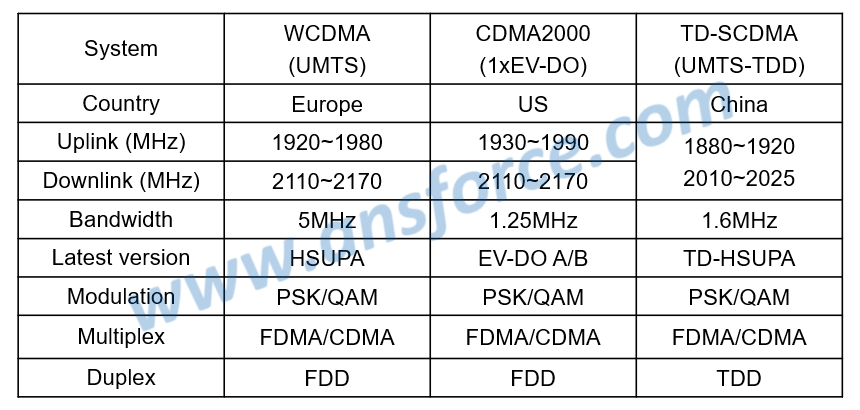
❒ Features of 3G mobile phone
➤WCDMA system: WCDMA is a system upgraded from European 2G GSM system and is the technology used by 3G mobile phone Universal Mobile Telecommunication System (UMTS). By extending the growth of 2G GSM system market, WCDMA is currently applied in about 80% of worldwide regions. From Table 3, WCDMA system has the upload frequency of 1920~1980MHz (bandwidth 60MHz) and the download frequency of 2110~2170MHz (bandwidth 60MHz), and belongs to Frequency Division Duplexing (FDD) with channel bandwidth of 5MHz, and also employs Frequency Division Multiple Access (FDMA) and Code Division Multiple Access (CDMA). However, because of using CDMA to discriminate different users, the size of channel bandwidth is not so important. WCDMA may be integrated with the current GSM, GPRS, and EDGE systems, so the telecom operators originally using GSM system all employ WCDMA system.
➤CDMA2000 system: CDMA2000 is a system upgraded from American 2G CDMA (IS-95) system. As shown in Table 12-6, CDMA2000 has an upload frequency of 1930~1990MHz (bandwidth 60MHz), a download frequency of 2110~2170MHz (bandwidth 60MHz), and belongs to FDD with a channel bandwidth of 1.25MHz. CDMA2000 employs both FDMA and CDMA and may be integrated the current CDMA(IS-95) system, Because the telecom operators originally using GSM system are impossible to replace their systems, it is hard to take over the business from WCDMA system.
Because the technologies for 4G mobile phones are not mature, WCDMA system in Europe first announced simplier 3.5G HSDPA system and 3.75G HSUPA system, and CDMA2000 system (1xEV-DO) in USA also announced 3.5G EV-DO Rev. A system and 3.75G EV-DO Rev. B system in response, and TD-SCDMA (UMTS-TDD) system of China also announced 3.5G TD-HSDPA system and 3.75G TD-HSUPA system in response, as shown in Fig. 1.
【Remark】The aforementioned contents have been appropriately simplified to be suitable for reading by the public, which might be slightly differentiated from the current industry situation. If you are the expert in this field and would like to give your opinions, please contact the writer. If you have any industrial and technical issues, please join the community for further discussion.
